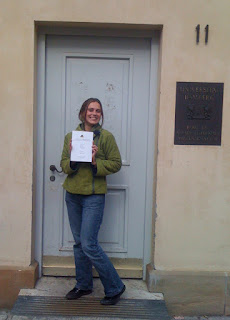I met with my colleagues Klaus and Hanswulf about our sites and monuments of Jerusalem project on Thursday September 30. Because the end of our project is still off in the future, we agreed on an interim solution. I will return to the idea that I had earlier and publish first a supplement volume to the original German edition about the sites and monuments of Islamic Jerusalem. It will take me only a few more months to finish that Islamic Jerusalem book.
That same day I had lunch with Ilse Sturkenboom, just after she had submitted her MA thesis in Islamic Art to the university. She had attended some of the courses I had taught at the university and she participated in my Humayma excavation in 2009. Ilse did not have another copy of the thesis with her, so in the photograph she is holding a copy of my Palestinian Customs book that I had given her as an alternative in front of the Oriental Studies Department.
Ilse Sturkenboom
On Friday October 1 I traveled to Mainz to attend the first day of a conference about the Saljuqs and Byzantines in Anatolia. I met there Johannes Pahlitz and the other Byzantinists at the University of Mainz.
Among my other activities, on Saturday October 9 I went on the nature hike with the Volkshochschule to southern Türingen. At one point we walked along the former East Germany-West Germany border. The camera on my iPhone was malfunctioning, so the photograph is fuzzy.
The foundations for the death strip along the East Germany border
In the fall many towns hold an autumn festival. On Sunday October 10 I went to a fall market in the town of Strullendorf, south of Bamberg, and the apple market in Reckendorf, northwest of Bamberg.
A school orchestra performing in Strullendorf
A band performing in Reckendorf
On Sunday October 3 there was a flea market in the city center of Bamberg.
The flea market
One afternoon I went to a showing of the movie Toy Story 3 at the end of its run. I was the only one in the theater for that showing.

















